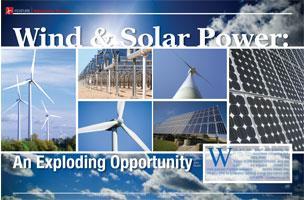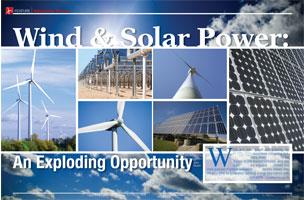

Wind and solar power are growing up. Quickly.
Once considered interesting-but-unrealistic by many power producers, or the domain of only environmentalists, wind and solar power are arguably the hottest and most-pursued of today’s renewable energy sectors. Indeed, they are emerging as generation-defining energy alternatives with potential to transform our nation and world.
And as solar and wind technologies advance, so does their potential to provide a partial solution to our escalating energy requirements. As wind and solar reduce our dependence on the world’s dwindling supply of oil and coal, they also improve air quality, offset greenhouse gas emissions and represent a potentially inexhaustible energy supply.
With benefits like that, investment and expanding capacity is following. The growing solar and wind power industries stimulate economies and create jobs, as investment in renewable energy resources surpassed $100 billion in 2007 according to the REN21.2008 “Renewables 2007 Global Status Report.”
These worldwide investments fall in multiple areas and underpin this emerging industry segment: research and development, production facilities and new installed capacity for renewable energy sources (which by definition excludes large hydro projects).
A rapidly growing capacity
Key components of the new renewable energy industry – wind, grid-connected solar photovoltaic (PV), solar heat collectors, biomass and geothermal – generated electricity production growth rates between 20 and 60 percent in 2007 over the prior year. Installed annual capacity from new renewable energy sources worldwide reached a total of 240 gigawatts in 2007 – or approximately 25 percent of the capacity of all nuclear power plants.
World wind-powered electricity generation capacity alone soared more than 60 percent in two years, increasing from 59 gigawatts in 2005 to 95 gigawatts in 2007. More than 21 gigawatts of capacity was added in 2007 alone, with the United States adding 2.5 gigawatts of new wind-powered electric capacity in 2007, raising its total to over 14 gigawatts.
World grid-connected solar photovoltaic capacity more than doubled since 2005 to 7.8 gigawatts in 2007, sustaining a 50 percent growth rate of installed capacity for the second year in a row. Germany alone added an additional 1 gigawatt of capacity in 2007, while the U.S. added 100 megawatts of new solar PV generating capacity.
Drivers of growth
Driving the growth of and investment in new sustainable energy sources are policy decisions designed to make solar and wind energy cost competitive with conventional grid electricity as rapidly as possible. By creating new markets for sustainable energy and requiring utilities to change the way they invest in future energy capacity, such policy decisions are creating incentive triggers for expanded research and investment in the development and operations of renewable energy facilities. Many of these policy decisions focus on Renewable Portfolio Standards, Feed-in-Tariffs, and Incentives for Siting, Production and Operation of renewable energy facilities.
Renewable Portfolio Standards require a certain portion of a utility’s power plant capacity or generation to come from renewable sources (whether solar, wind, geothermal or hydro) by a designated date. Some 26 states, primarily in the northeastern and western regions of the United States, have adopted mandatory compliance, although the deadlines, percentage of power generation required and approved type of renewable sources all vary by state. Four other states have adopted voluntary compliance guidelines; more than a dozen other states are considering similar types of requirements. Only three Southern states have passed such legislation (Source: Pew Center on Global Climate Change).
California, for example, is one of 25 states that have adopted laws requiring electric utilities to use more renewable resources, sending utilities scrambling to line up wind and solar projects across the country. For utilities long reliant on coal, nuclear energy and natural gas to power generating plants, the hot topics have become biomass initiatives in Minnesota, solar plants in the California and Arizona deserts, and wind farms in places like West Texas, Kansas and the Dakotas.
Because California law requires utilities to get 20 percent of their electricity from renewable sources by 2010, utilities like Sempra Energy, based in San Diego, are aggressively exploring new sites and facilities to bring solar power to the city. Locations like California’s Imperial Valley, where the wind blows steadily, it rains very little and temperatures hit triple digits throughout the summer, have become incredibly appealing.
With contracts in hand to boost renewable energy to 13 percent of its generation portfolio by 2010, utilities like Sempra are working overtime to meet the 20 percent threshold.
Since originating in Germany, Feed-in tariffs have grown increasingly popular in Europe and in the U.S., with Spain, France, Italy, Greece and numerous domestic states employing them. Feed-in tariffs assume that all parties have the right to feed-in electricity to a central utility grid, where the utilities buy the surplus electricity at an above-market rate for a fixed number of years to encourage further compliance. Many states, such as California, have programs where a utility purchases the power at a premium rate and the consumer receives a financial credit toward their electric bill. (Source: DSIRE USA).
Nearly every state (excluding only Arkansas and West Virginia) offers incentives in the form of tax reductions – including personal, sales, corporate and property tax incentives - for investment in renewable energy. Only six states offer incentives in all four tax classifications, while there are also a number of loans, bonds, industry support and production incentives offered to encourage businesses to invest in more environmentally-friendly energy sources. Yet as the pressure grows to generate more energy from renewable sources, utilities are getting more aggressive in their explorations of alternatives.
Richmond, VA-based utility Dominion recently announced it would collaborate with BP's alternative-energy unit to develop, own and operate wind farms in Virginia, part of its own efforts to attain a level of 12 percent of energy from renewable sources by 2022. While considering several sites in western Virginia and near the coastline, Dominion currently obtains less than 3 percent of its energy from renewable resources, and needs to add 1,325 megawatts of renewable capacity to meet the state target – equal to almost two new coal-fired plants. Driving their decisions? Virginia’s regulators will allow utilities an additional two percentage points on their regulated profit margins for those able to comply with new standards for renewable energy.
While the type and number of incentives varies by state, most offer financial incentives in the form of a rebate or grant for investment in renewable energy sources. Industry support and bonds are the least popular financial incentives having only 20 and 3 states offering these, respectively.
Regardless, policy, laws and incentives are all driving the market growth and encouraging utilities to invest in new sustainable energy sources.
Siting Considerations & Drivers – Wind and Solar Facilities
As with siting in most industries, there are four phases in the process and each phase has different site location drivers. The four phases are:
Headquarters and R&D operations
Production of necessary supply materials
Construction of the final product
Installation in the electric generating location.
Ironically, the primary site selection drivers for each of these phases are different, and the combination of all four phases in one location often results in a less-than-optimal location for at least one of the aspects of the operation.
For the Headquarters and R&D operations phase, primary siting drivers include access to university research, availability of highly skilled employees, investment funding for the company, and a knowledge cluster that will assist and sustain the company start-up, operations, and research and development efforts. Both U.S. coasts are great locations for these operations, with dense populations, developed research bases and entrepreneurial support.
For wind and solar energy generation, the key components necessitated in energy production –polysilicon for solar, and turbines for wind – present a different set of requirements of the siting. The main drivers for polysilicon siting are a low cost of electricity, robust electrical supply system, isolated industrial location, and a cluster of chemical workers with technical training.
The state of Washington, the TVA region and the state of New York are good candidates when it comes to areas of the country with large bases of hydro power generation. For the production of turbines, drivers include a significant base of experienced metal workers, historically strong manufacturing environment, and a readily available core of engineering talent – all found in the Greenville, SC area where GE Turbine Operations are located.
Siting drivers for the construction and assembly in the field of the final product for generation of electricity is again different for wind and solar power. For wind generation systems, the final transportation to the location of the wind farms can be a significant cost, and production of rotors and towers in a location close to the wind farms can prove financially advantageous. For solar, the panels are relatively compact and transportation is less of a factor. Incentives and tax consequences may play an important role in location analysis for this final phase of production of the product.
Finally, the location of the wind and solar farms themselves will be impacted by the development of the electric markets, electricity grid access, and the availability and requirements of wind power and solar transmission.
"The biggest barrier, we think, will be the transmission necessary," noted Mike Bull, deputy director of Minnesota's office of energy security, in a recent interview. With an ambitious goal of 25 percent renewable energy by the year 2025 – requiring the addition of more than 5,000 megawatts of renewable projects – Minnesota’s efforts to bring power from some of the state's windiest areas to its most populous will require 700 miles of new transmission lines.
"There's a lot of attention, a lot of concern and a lot of effort going on to make sure we have the transmission capacity so we don't miss the milestones,” Bull said. "No one wants to be responsible for not meeting them."
All four phases have their own unique set of requirements and demands to optimize the site, and to generate appropriate returns on investment required of the capital investment demanded. Tax incentives, rebates and grants play an important role in stimulating these growing segments of the industry marketplace.
States taking the lead
Although the U.S. Congress has failed to set a nationwide standard for utilities' use of renewable resources in its energy legislation, state legislatures are steering utilities away from power plants that generate greenhouse gases. With wind power accounting for 30 percent of all new U.S. generating capacity last year, (Source: American Wind Energy Association), efforts appear to be paying off.
Arizona Public Service, for example, has announced plans to build a 280-megawatt solar power plant, using mirrors to concentrate solar energy, heat fluid and generate steam for turbines, while also adding a small, 24-megawatt biomass plant.
Still, the lack of a national policy and a patchwork of oft-conflicting state regulations slow investment in some of the most economical wind and solar projects. Despite better wind prospects outside Virginia, for example, Dominion wants to change its footprint in its home state – and take advantage of rate concessions being offered.
In California, where a federal standard might allow utilities to link up with projects outside the state, including wind power in Texas or Wyoming where wind blows stronger and steadier, the absence of federal oversight slows progress.
Big growth to come
According to a study by the Lawrence Berkeley National Laboratory, current state renewable-electricity requirements alone will lead to the addition of 60 gigawatts of renewable capacity by 2025, equal to nearly 5 percent of projected U.S. electricity generation, and equivalent to about 40 new nuclear power plants. This comes with only about half of the 50 states having enacted legislation on renewable energy sources.
Thus, with a savvy push from the Federal government and more cohesion to state regulations and mandates, it can be anticipated that the 60 gigawatt requirements could well be doubled, or more, in the next 15 years. And as America’s rate of investment in renewable energy resources accelerates over that period to meet the growing needs, expect many new headquarters, research and development, and production facilities to be sited, and built, to meet this escalating need.
Author’s Note: Many of the statistics included in this article are sourced from reports and research of the Renewable Energy Policy Network for the 21st Century (REN21.2008). The author acknowledges their contributions with appreciation.

